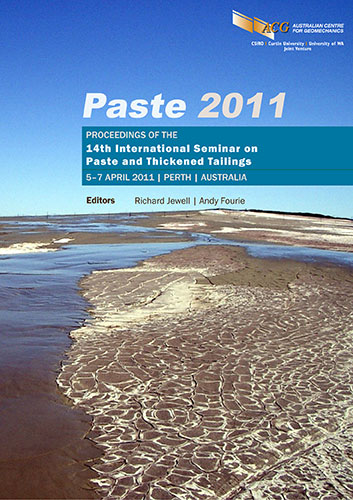Optimising unit operations in paste dewatering

|
Authors: Palmer, J; Viswanathan, V |
DOI https://doi.org/10.36487/ACG_rep/1104_06_Palmer
Cite As:
Palmer, J & Viswanathan, V 2011, 'Optimising unit operations in paste dewatering', in R Jewell & AB Fourie (eds), Paste 2011: Proceedings of the 14th International Seminar on Paste and Thickened Tailings, Australian Centre for Geomechanics, Perth, pp. 57-66, https://doi.org/10.36487/ACG_rep/1104_06_Palmer
Abstract:
Current practises in tailings handling are gradually shifting as there are increased pressures for water recovery and changing legislations for tailings impoundment. Many studies have been undertaken on paste thickening and tailings filtrations that have focused on a single unit operation. This study investigates the interrelationships between gravity separation, particle separation, filtration, pumpability and materials handling in an attempt to optimise the process both from a process and operational expense (OPEX) perspective. Paste thickeners can achieve high levels of water recovery yet their underflow is difficult to transport to disposal. High shear in the settling zones has significantly increased underflow densities but the discharge has a high viscosity that is at the limit of current pumping technologies and there is an issue with the distribution in the impoundment. Filtration can achieve dry cake for solid disposal at the expense of high costs. Low feed densities and ultra fine particles can significantly impact on both the unit capacity and achievable moisture. More difficult slurries require increasingly higher pressures for separation and this substantially increases the separation costs. Currently, tailings are a composite of all processing plants wastes and represent solids with a wide range of particle sizes, process water, excess reagents and spillage. Parts of these streams are relatively easy to dewater while others may be extremely difficult to handle. As a composite they tend to behave more like the worst component. By changing the material flows and altering the duty points of filters and paste thickeners, superior performance can be achieved compared to either technology operating in isolation.
References:
Beloglazov, I.N., Golubev, V.O., Tikhonov, O.N., Mikheyev, A.I., Beloglazov, I.I., Vorobyov, S.A., Palmer, J., Kuukka, J., Jaaskelainen, E. and Rogov, S.N. (2008) Filtration of Process fine materials, Ore and Metals, Russia.
Jewell, R.J. and Fourie, A.B. (eds) (2006) Paste and Thickened Tailings – A Guide, 2nd edition, Australian Centre for Geomechanics, Perth, 242 p.
Osborne, D.G. (1981) Vacuum Filtration – Part I, in Solid-Liquid Separation, 2nd Edition, L. Svarovsky (ed), Butterworth & Co Ltd: London, p. 349.
Wakeman, R.J. and Tarleton, E.S. (2005) Solid/liquid separation: principles of industrial filtration, Elsevier, Oxford, UK.
© Copyright 2024, Australian Centre for Geomechanics (ACG), The University of Western Australia. All rights reserved.
View copyright/legal information
Please direct any queries or error reports to repository-acg@uwa.edu.au
View copyright/legal information
Please direct any queries or error reports to repository-acg@uwa.edu.au